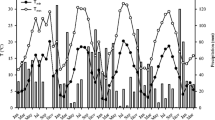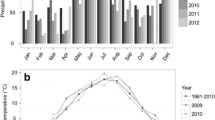Abstract
The coppice is a very flexible cultural system producing several calibers adapting to the demands of the market. Small-caliber roundwood from sweet chestnut (Castanea sativa Mill.) coppices, formerly in great demand, is now less interesting for the market. Thus, the improvement of coppices management by applying alternative silvicultural models in order to obtain benefits and sustainability is essential. For this purpose, four permanent plots (P1–P4) were established in 1994 to monitor different coppice management systems. The plots were installed in a coppice which resulted from the final clear cut of a sweet chestnut high-forest stand in 1992, at 50 years old. Three silvicultural management models were tested in order to produce roundwood of small (P1), medium (P2), and large (P4) diameters. A control plot was established without any type of silviculture which corresponds to most of the existing chestnut coppices (P3 = without intervention). Thinnings were applied in the plots according to the respective management model. Twenty-four years after the sprouting of the coppice, the silvicultural models were evaluated according to their objectives in terms of growth, yield, and quality of the sawlogs. This assessment period corresponds to the end of the rotation period for P1, and the results are in accordance with expected values. In P2 and P4 the observed growth closely matches expectations for this growth stage of the coppice. The quality of the sawlogs is clearly superior to that of the plot without intervention. Comparing the mean dendrometric values, higher values were observed in plots where the models were applied. The results also show that when roundwood is used for saw-timber, silvicultural management is essential.



Similar content being viewed by others
References
Amorini E, Manetti MC (2000) Le fustaie da legno di castagno del Monte Amiata. Ann Ist Sper Selv Arezzo 28:53–61
Assmann E (1961) Waldertargskunde. Bayr. Landw, Müchen
Assmann E (1970) The principles of forest yield study. English transl. S.H. Gardiner, Pergamon Press Ltd., Oxford
Birdsey R, Duffy P, Smyth C, Akurz W, Dugan AJ, Houghton R (2018) Climate, economic, and environmental impacts of producing wood for bioenergy. Environ Res Lett 13:050201
Bourgeois C (1987) Améliorer les taillis de châtaignier. Forêt Entreprise 44:8–15
Bourgeois C (1992) Le châtaignier un arbre, un bois. IDF, 1ère ed., Paris
Bourgeois C, Sevrin E, Lemaire J (2004) Le châtaignier un arbre, un bois. IDF, 2eme ed., Paris
Burkhart HE (1977) Cubic-foot volume of loblolly pine to any merchantable top limit. South J Appl For 1:7–9
Cao QV, Burkhart HE, Max TA (1980) Evaluation of two methods for cubic-volume prediction of loblolly pine to any merchantable limit. For Sci 26(1):71–80
Cutini A (2001) New management options in chestnut coppices: an evaluation on ecological bases. For Ecol Manag 141:165–174
Deusen PCV, Sullivan AD, Matney TG (1981) A prediction system for cubic foot volume of loblolly pine applicable through much of its range. South J Appl For 5:186–189
Fortuna ERM (1969) Tabelas de volume para o castanheiro bravo. Estudos e Informação 245, Secretaria de Estado da Agricultura, DGSFA, Lisboa, Portugal
Fuller RJ, Moreton BD (1987) Breeding bird population of Kentish sweet chestnut (Castanea sativa) coppice in relation to age and structure of the coppice. J Appl Ecol 24:13–27
Geraldes SAA (2011) Avaliação de modelos silvícolas e validação de ferramentas de gestão para o castanheiro em Trás-os-Montes. Bragança: Instituto Politécnico de Bragança, Escola Superior Agrária. Dissertation, Mestrado em Gestão de Recursos Florestais
Harrison W, Burk T, Beck D (1986) Individual tree basal area increment and total height equations for Appalachian mixed hardwoods after thinning. South J Appl For 10:99–104
Honer TG (1965) A new total cubic-foot volume function. For Chron 41:476–493
Huber PJ (1964) Robust estimation of a location parameter. Ann Math Stat 35:73–101
Iamshchikov V (2017) Evaluation of management models in a trial of Castanea sativa Mill. coppice in northern Portugal. Dissertation, Instituto Politécnico de Bragança, ESA, Bragança, Portugal
Icnf IP (2013) IFN6—Áreas dos usos do solo e das espécies florestais de Portugal continental. Resultados preliminares. Instituto da Conservação da Natureza e das Florestas, Lisboa
INMG (1991) O clima de Portugal. Fascículo XLIX, vol. 3, 3a Região
Kraft G (1884) Beiträge zur Lehre von den Durchforstungen, Schlagstellungen und Lichtungshieben. Klindworth’s Verlag, Hannover
Luís JFS, Monteiro ML (1998) Dynamics of a broadleaved (Castanea sativa) conifer (Pseudotsuga menziesii) mixed stands in Northern Portugal. For Ecol Manag 107:183–190
Matney TG, Sullivan AD (1980) Estimation of merchantable volume and height of natural grown slash pine trees. Arid land resources inventories workshop, La Paz, Mexico
Menéndez-Miguélez M, Álvarez-Álvarez P, Majada J, Canga E (2015) Effects of soil nutrients and environmental factors on site productivity in Castanea sativa Mill. coppice stands in NW Spain. New For 46:217–233
Menéndez-Miguélez M, Álvarez-Álvarez P, Majada J, Canga E (2016) Management tools for Castanea sativa coppice stands in northwestern Spain. Bosque 37(1):119–133
Monteiro ML, Patrício MS (1996) O castanheiro: modelos de gestão. Revista Florestal ix(4):51–56
Myers RH (1986) Classical and modern regression with applications. Duxbury Press, Boston
Ogaya N (1968) Kubierungsformeln und Bestandesmassenformeln. Dissertation, Univ. Freiburg I. Br
Parresol BR, Hotvedt JE, Cao QV (1987) A volume and taper prediction system for bald cypress. Can J For Res 17:250–259
Patrício MS (1996) Análise do crescimento da fase juvenil de um ensaio de densidade de varas numa talhadia de castanheiro. Dissertation, Universidade Técnica de Lisboa, Instituto Superior de Agronomia, Lisboa
Patrício MS (2006) Análise da Potencialidade Produtiva do Castanheiro em Portugal. Dissertation, Universidade Técnica de Lisboa, Instituto Superior de Agronomia, Lisboa
Patrício MS, Nunes L (2017) Density management diagrams for sweet chestnut high-forest stands in Portugal. iForest 10:865–870
Patrício MS, Monteiro ML, Nunes LF, Mesquita S, Beito S, Casado J, Guerra H (2005) Management models evaluation of a Castanea sativa coppice in the northeast of Portugal. Acta Hort 693:721–726
Patrício MS, Geraldes S, Nunes LF, Monteiro ML (2009) Sustainable management models applied to chestnut coppice in the north-east of Portugal. FAO—XIII world forest congress, 16–23 October, Buenos Aires
R Core Team (2018) R: a language and environment for statistical computing. R Foundation for Statistical Computing, Vienna
Reed DD, Green EJ (1984) Compatible stem taper and volume ratio equations. For Sci 30(4):977–990
Romane F, Houssard C (1995) The sustainability of chestnut ecosystem. In: Romane F (ed) Sustainability of mediterranean ecosystems. Case study of the chestnut forest. European commission, Brussels, ecosystem research report no. 19, pp 173–176
Schumacher FX, Hall F (1933) Logarithmic expression of timber-tree volume. J Agric Res 47:719–734
Spurr SH (1952) Forest inventory. Ronald Press, New York
Tomé M (1988) Modelação do crescimento da árvore individual em povoamentos de Eucalyptus globulus Labill. (1a rotação) Região Centro de Portugal. Dissertation, UTL-ISA, Lisboa
Acknowledgements
Conception of the study, data analysis, drafting of the manuscript and critical revision: MSP and LN. Contributed materials: MSP and MLM. Data used in this study was collected with the financial support of the EU project AIR 2-CT94-0905—MEDCOP: Improvement of Coppice Forests in the Mediterranean Region, AGRO Program, Project 267: Sustainable Management of Chestnut Forested Areas in High-Forest and Coppice Systems, and Project PTDC/AGRCFL/68186/Mixed forests: Modeling, dynamics and geographical distribution of productivity and carbon storage in mixed forest ecosystems in Portugal, founded by the Portuguese Science Foundation (FCT) and FEDER—COMPETE Program. The authors wish to thank the availability and cooperation of Forest Services (ICNF) for this study.
Author information
Authors and Affiliations
Corresponding author
Additional information
Publisher's Note
Springer Nature remains neutral with regard to jurisdictional claims in published maps and institutional affiliations.
Rights and permissions
About this article
Cite this article
Patrício, M.S., Nunes, L. & Monteiro, M.L. Does the application of silvicultural management models drive the growth and stem quality of sweet chestnut coppices towards sustainability?. New Forests 51, 615–630 (2020). https://doi.org/10.1007/s11056-019-09748-3
Received:
Accepted:
Published:
Issue Date:
DOI: https://doi.org/10.1007/s11056-019-09748-3




